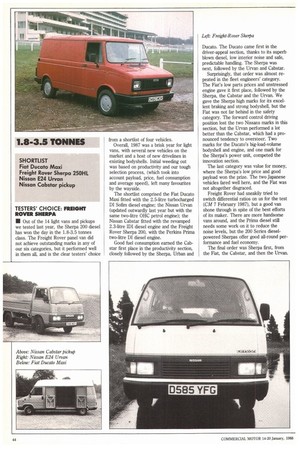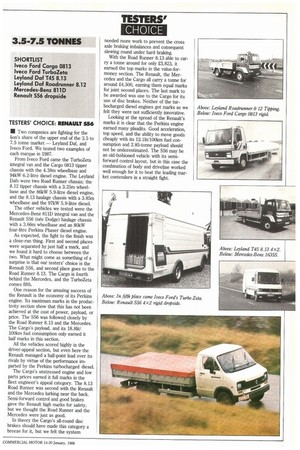TESTERS' CHOICE: FREIGHT ROVER SHERPA • Out of the 14
Page 46

Page 47

If you've noticed an error in this article please click here to report it so we can fix it.
light vans and pickups we tested last year, the Sherpa 200 diesel has won the day in the 1.8-3.5 tonnes class. The Freight Rover panel van did not achieve outstanding marks in any of our six categories, but it performed well in them all, and is the clear testers' choice from a shortlist of four vehicles.
Overall, 1987 was a brisk year for light vans, with several new vehicles on the market and a host of new drivelines in existing bodyshells. Initial weeding out was based on productivity and our tough selection process, (which took into account payload, price, fuel consumption and average speed), left many favourites by the wayside.
The shortlist comprised the Fiat Ducato Maxi fitted with the 2.5-litre turbocharged DI Sofi.m diesel engine; the Nissan Urvan (updated outwardly last year but with the same two-litre OHC petrol engine); the Nissan Cabstar fitted with the revamped 1D1 diesel engine and the Freight Rover Sherpa 200, with the Perkins Prima two-litre DI diesel engine.
Good fuel consumption earned the Cabstar first place in the productivity section, closely followed by the Sherpa, Urban and Left: Freight-Rover She, Pa Ducato. The Ducato came first in the driver-appeal section, thanks to its superb blown diesel, low interior noise and safe, predictable handling. The Sherpa was next, followed by the Urvan and Cabstar.
Surprisingly, that order was almost repeated in the fleet engineers' category. The Fiat's low parts prices and unstressed engine gave it first place, followed by the Sherpa, the Cabstar and the Urvan. We gave the Sherpa high marks for its excellent braking and strong bodyshell, but the Fiat was not far behind in the safety category_ The forward control driving position lost the two Nissans marks in this section, but the Urvan performed a lot better than the Cabstar, which had a pronounced tendency to oversteer. Two marks for the Duc,ato's big-load-volume bodyshell and engine, and one mark for the Sherpa's power unit, competed the innovation section.
The last category was value for money, where the Sherpa's low price and good payload won the prize. The two Japanese vehicles fared well here, and the Fiat was not altogether disgraced.
Freight Rover had sneakily tried to switch differential ratios on us for the test (CM 7 February 1987), but a good van shone through in spite of the best efforts of its maker. There are more handsome vans around, and the Prima diesel still needs some work on it to reduce the noise levels, but the 200 Series dieselpowered Sherpas offer good all-round performance and fuel economy.
The final order was Sherpa first, from the Fiat, the Cabstar, and then the Urvan. • Two companies are fighting for the lion's share of the upper end of the 3.5 to 7.5 tonne market — Leyland Daf, and Iveco Ford. We tested two examples of each marque in 1987.
From Iveco Ford came the TurboZeta integral van and the Cargo 0813 tipper chassis with the 4.38m wheelbase and 94kW 6.2-litre diesel engine. The Leyland Dafs were two Road Runner chassis; the 8.12 tipper chassis with a 3.25m wheelbase and the 86kW 5.9-litre diesel engine, and the 8.13 haulage chassis with a 3.85m wheelbase and the 97kW 5.9-litre diesel.
The other vehicles we tested were the Mercedes-Benz 811D integral van and the Renault S56 (née Dodge) haulage chassis with a 3.66m wheelbase and an 80kW four-litre Perkins Phaser diesel engine.
As expected, the fight to the finish was a close-run thing. First and second places were separated by just half a mark, and we found it hard to choose between the two. What might come as something of a surprise is that our testers' choice is the Renault S56, and second place goes to the Road Runner 8.13. The Cargo is fourth behind the Mercedes, and the TurboZeta comes fifth.
One reason for the amazing success of the Renault is the economy of its Perkins engine. Its maximum marks in the productivity section show that this has not been achieved at the cost of power, payload, or price. The S56 was followed closely by the Road Runner 8.13 and the Mercedes. The Cargo's payload, and its 18.8lit/ 100km fuel consumption only earned it half marks in this section.
All the vehicles scored highly in the driver-appeal section, but even here the Renault managed a half-point lead over its rivals by virtue of the performance imparted by the Perkins turbocharged diesel.
The Cargo's unstressed engine and low parts prices earned it full marks in the fleet engineer's appeal category. The 8.13 Road Runner was second with the Renault and the Mercedes lurking near the back. Semi-forward control and good brakes gave the Renault high marks for safety, but we thought the Road Runner and the Mercedes were just as good.
In theory the Cargo's all-round disc brakes should have made this category a breeze for it, but we felt the system needed more work to prevent the cross axle braking imbalances and consequent slewing round under hard braking.
With the Road Runner 8.13 able to carry a tonne around for only 23,823, it earned the top marks in the value-formoney section. The Renault, the Mercedes and the Cargo all carry a tonne for around 24,500, earning them equal marks for joint second places. The last mark to be awarded was one to the Cargo for its use of disc brakes. Neither of the turbocharged diesel engines got marks as we felt they were not sufficiently innovative.
Looking at the spread of the Renault's marks it is clear that the Perkins engine earned many plaudits. Good acceleration, top speed, and the ability to move goods cheaply with its 13.11it/1001un fuel consumption and 2.85-tonne payload should not be underestimated. The S56 may be an old-fashioned vehicle with its semiforward control layout, but in this case the combination of body and driveline worked well enough for it to beat the leading market contenders in a straight fight.




















































































